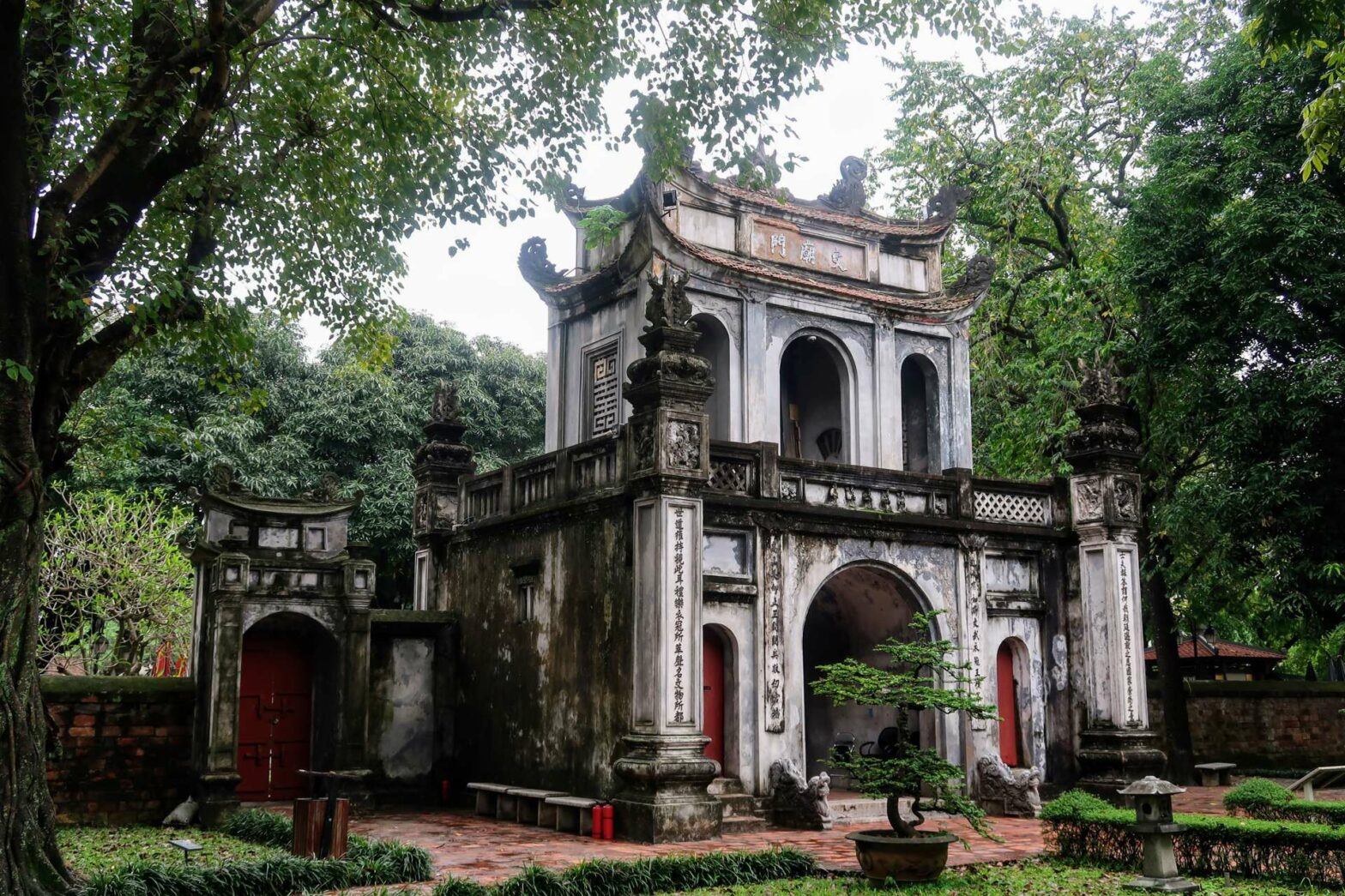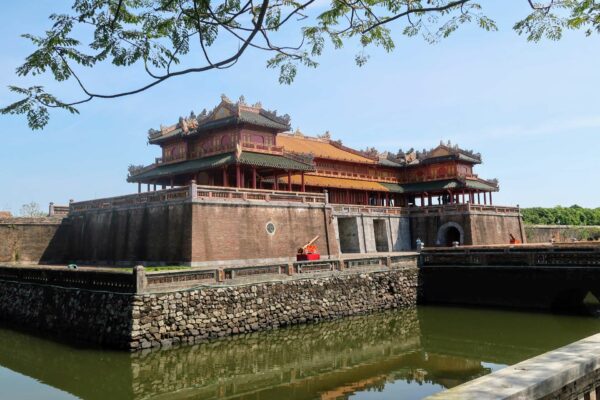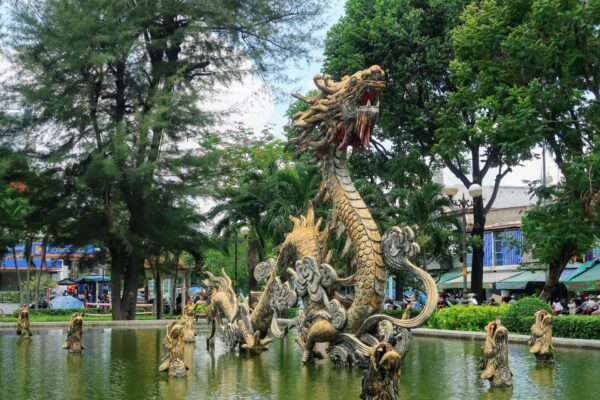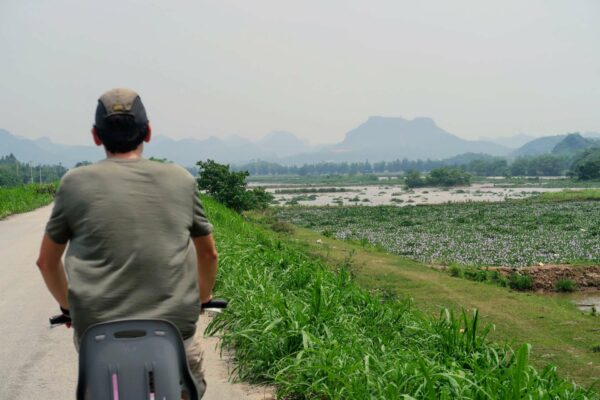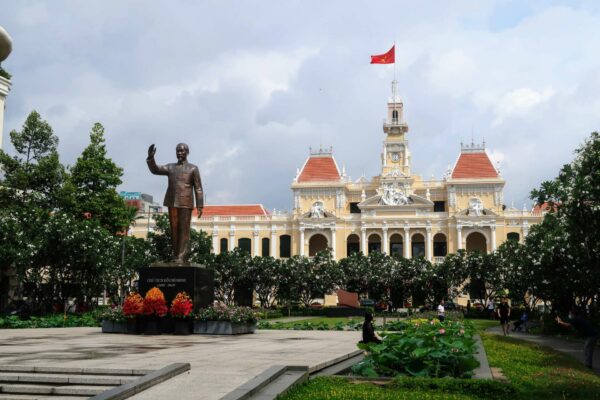By Vicky · Published Sep. 27th, 2023 · Updated Dec. 16th, 2023
When you buy through links highlighted with an asterisk (*) on this site, we may earn a small affiliate commission at no cost to you.
Visit the famous heritage sites of Hanoi on this walking tour to all the main attractions, best seen over two days.
Page Contents:
How to get to Central Hanoi
To get to central Hanoi from Noi Bai International Airport, you can take a normal taxi waiting at the exits, or take a Grab/Gojek (both like Uber). Alternatively, you can easily reserve a private transfer from the airport to your hotel* in advance.
If you opt for Grab or Gojek, make sure to download these apps in advance. To use these you’ll need your phone to work as soon as you arrive in Vietnam. You can easily get a Vietnamese SIM at the airport, but you’ll need to have a working card or cash. There are several ATMs at the airport, but make sure you know your pin!
Hanoi Walking Tour Route Map
Get the route by downloading the .gpx or .kml file below. For navigation with Maps.me on your mobile phone, simply download the .kml file and open to add it to the Maps.me bookmarks.
Tips for Hanoi Walking Tour
- Download the Grab or Gojek apps before you arrive in Vietnam to easily get a taxi.
- Download the Maps.Me app and the area around Hanoi so you’re never lost.
- It can be very dusty and polluted, facemasks can be useful!
- There are many cheap eats along the way. Many places don’t accept card, so have enough cash (get a Wise Card* for cheap money conversion and cash withdrawals).
- Walk the Old Quarter area on Day 1, and the NorthWest on Day 2, or walk the entire thing in one day if you don’t visit inside many places.
Attractions on the Hanoi Walking Tour
On this walking tour you’ll see the main sights and attractions of Hanoi. You should plan to spend at least two days in Hanoi to see all the top sights, or much longer if you also want to visit all the museums. This is a free, self-guided walking tour. If you’re interested in food, check out the guided street food walking tour* in the Old Quarter. If you are pressed for time, see the main attractions of Hanoi in one day on this packed guided tour*, or get tickets for the hop-on hop-off bus*.
- Saint Joseph’s Cathedral
- Old Quarter
- Dong Xuan Market
- Long Bien Bridge
- Bach Ma Temple
- Heritage House
- Hoan Kiem Lake
- Jade Island
- Turtle Tower
- French Quarter
- National Museum of Vietnamese History
- Vietnamese Women’s Museum
- Hoa Lo Prison Museum
- Temple of Literature
- Fine Arts Museum of Vietnam
- Vietnam Military History Museum
- Imperial Citadel of Thang Long
- Ho Chi Minh Mausoleum Complex
- Ho Chi Minh Mausoleum
- Ho Chi Minh Museum
- Presidential Palace
- One Pillar Pagoda
- Ho Chi Minh’s Stilt House
- West Lake
- Quan Thanh Temple
- Tran Quoc Pagoda
When you only have one day in Hanoi, the top sights to visit are the Old Quarter, the Temple of Literature, the Imperial Citadel of Thang Long and the Ho Chi Minh Mausoleum Complex. You could just about squeeze this into one day, or check out the guided tour of Hanoi in one day*.
Hanoi Walking Tour Route
This walking tour starts from St Joseph Cathedral in the centre of Hanoi. There are many places to stay nearby* in the Old Quarter, ranging from cheap to luxurious. There are also many cafes surrounding the cathedral square if you want a drink or a bite to eat.
1. St Joseph’s Cathedral
Key Information: Open 8-noon and 2-6pm every day. Free entry.
St Joseph Cathedral* is a large, neo-Gothic cathedral, finished in 1886. It’s the oldest church in Hanoi, built by the French to resemble Notre Dame in Paris. Mass is held several times a day, the most popular service by far being the Sunday 6 pm event. Crowds spill out of the cathedral into the streets, where the hymns are broadcast on loudspeakers so everyone can listen.
The square in front is now a popular place to take photos of the large frontal facade. The main doors can be used to enter the church only during mass. At other times, you have to walk around towards the back to a side door (where you might have to ring a small bell for the door to be opened).
Directions: Facing away from the cathedral, head a short distance left on the street to visit the next top.
Ly Trieu Quoc Su Pagoda is just around the corner from the Cathedral and is worth a quick look. People come here to wish for happiness and prosperity, worshipping a monk who lived around 1000 years ago.
Directions: Return to the cathedral and take the street opposite. Turn left at the T-junction. From here make your way through the Old Quarter. There are many nice lanes, it doesn’t really matter which you take, but try and reach the stops mentioned below.
2. Old Quarter
Hanoi’s Old Quarter* is filled with a labyrinth of lanes. It’s a great place to try the delicious street food. Many of the streets here specialize in one particular product, such as steel, pans, candles, or flags, etc. It’s fun to explore these lanes, where all the shops sell the same thing and you can see people working on products or restoring items.
Directions: Wind your way through the streets to reach Dong Xuan Market.
Dong Xuan Market is the largest market in Hanoi. On offer are fresh fruit and veg, meat & fish, dry goods, souvenirs, cheap clothes, arts and crafts, and much more. It remains lively till late evenings Fri-Sun.
Directions: Head a little further on to the bridge.
Long Bien Bridge* was designed by Gustave Eiffel (who built the Eiffel Tower) and has been bombed on several occasions, to be hastily reconstructed. In the river below you can see farms of vegetables and bananas. It’s closed to cars but there are many motorbikes so a facemask could be useful here, but you don’t have to walk too far along it to get the impression. You can also glimpse the Hanoi Ceramic Mosaic Mural in this area, in the Guinness Book of World Records for being the longest mural in the world.
Directions: Return back and find the old gate.
Don’t miss the Old East Gate, the only one of 16 medieval gates in the city to remain.
Directions: From the gate walk towards Bach Ma Temple.
Bach Ma Temple
Key Information: Open 8-11am and 2-5pm Tue-Sun. Free entry.
Bach Ma Temple, or White Horse Temple, was originally constructed in the 11th century by the Emporer, who supposedly followed a white horse to this site, where he then built a city.
Directions: Wind your way towards Heritage House.
Heritage House* (also called Traditional House or Ancient House) is a fully restored property from the 19th century in the Old Quarter. It was restored in 1999 and is an example of a typical old Vietnamese, Hanoi home. A tour of the house doesn’t take too long, up to 30 minutes.
Directions: Head south and then take a right to the Lake.
3. Hoan Kiem Lake
Hoan Kiem Lake* is a relatively peaceful place to stroll around, especially nice in the early mornings or as the sun sets. From Friday to Sunday, traffic is banned after 7pm making it particularly nice. According to legend, in the 15th century the empower was sent a magical sword from heaven. After the war, a turtle took the famous sword and disappeared into the lake with it. The Turtle Tower, or Thap Rua, is a little tower on a small island in the lake and now the symbol of Hanoi.
Ngoc Son Temple (on Jade Island) covers the other, larger island on the lake, and you can walk across a bridge to this one. Ngoc Son Temple is open 8am-6pm and costs $1.50/0.75 per adult/concession to enter. The name of the temple means ‘Temple of the Jade Mountain’.
Directions: Walk to the far end of the lake and turn left. Pass the grand opera house and on to the National Historical Museum.
4. French Quarter
To the south and southeast of Hoan Kiem Lake lies the French Quarter. There are rather grand boulevards, fancy shopping streets, and French-Oriental architecture to be seen.
As you walk along the street you’ll pass the wonderful Hanoi Opera House*. This is a neoclassical monument, in the French colonial style. It was built in 1911 and later taken over by the Viet Minh (anti-french fighters) who used the balcony here to announce their takeover of the city. You can see an opera here (book ahead), or go on a guided 50-minute tour (at 2:30, 3:30 or 4:30pm). There’s not just opera, but theatre, dance, and other events.
Further to the south of the lake, there’s not much left reminiscent of France. You can see several former grand villas in various states of disrepair, though several have been demolished and built over. There are some wide tree-lined avenues and it’s a quieter area of town.
National Museum of Vietnamese History
Key Information: Open 8-noon and 1:30-5pm every day. Tickets are $2/0.5 per adult/concession, with a small extra fee for cameras. Audioguide included.
The National Museum of Vietnamese History* is in a great building, so it’s worth looking at the outside even if you don’t go in. The architecture is a blend of Chinese and French design. Inside you’ll find Hindu statues from the southeast Asian Khmer and Champa kingdoms, bronze statues, as well as exhibitions about the French occupation and the Communist party.
There are a couple of other worthwhile museums in the area, stops 5 and 6 on this walking tour of Hanoi.
Directions: Walk through the French Quarter towards the centre and to the Vietnamese Women’s Museum.
5. Vietnamese Women’s Museum
Key Information: Open 8am-5pm. Tickets are $1.50/0.75 per adult/concession.
The Vietnamese Women’s Museum* is a great museum and includes interesting exhibits about Vietnamese society, women during the war, marriage customs, and ethnic minority groups. You could easily spend 1-2 hours here.
Directions: Continue along the street to the next museum.
6. Hoa Lo Prison Museum
Key Information: Open 8am-5pm. Tickets are $1.50/free for adults/concessions. An audio guide is available but there are plenty of captions in English (and French) anyway. You could spend 1-2 hours here.
Hoa Lo Prison Museum* is located at the remains of the Hoa Lo Prison, which was named the ‘Hanoi Hilton’ by US prisoners of war. The well-organized exhibits are about the struggle for independence from France and the following war with America. One of the American pilots imprisoned here was Senator John McCain, and you can still see some of his stuff on display here. However, Hoa Lo never performed its function of prison very well, since many inmates escaped over the walls. It’s perhaps slightly biased to show the Vietnamese in a good light, but you’ll still learn a lot about the history of Vietnam from visiting.
The Ambassadors Pagoda (8-11am & 1-4pm daily, free entry) is just opposite the museum. It’s a quiet, peaceful area away from the hustle and bustle, so a good place to have a little rest. The name comes from the tradition of Ambassadors from Buddhist countries staying in a guesthouse on the grounds during the 17th century.
Directions: Continue onwards and cross the railway to the Temple of Literature, a highlight of Hanoi.
7. The Temple of Literature
Key Information: Open 8am-6pm. Tickets are $1.50/0.75 per adult/concession. Audioguide included.
The Temple of Literature* is one of the must-see sights in Hanoi. It’s a temple in the traditional Vietnamese style, built in honour of literary scholars, including Confucious. The Emporer founded this temple way back in 1070. There are many statues of Confucious, and students still come here to pray for success in their exams. It can be busy with tour groups in the middle of the day, so early mornings or late afternoons are best for a peaceful visit.
Directions: Head along the outside of the temple walls to reach the next stop.
8. Fine Arts Museum of Vietnam
Key Information: Open 8:30 am-5 pm. Tickets are $2/0.5 per adult/concession. Audioguide for a small extra fee (on your own phone – WiFi is available at the museum to download the app).
The Fine Arts Museum of Vietnam* is located just to the north of the Temple of Literature. There are many local artworks here, including Champa carvings, amazing statues of the Buddhist Goddess of Compassion Guan Yin (or Avalokiteshvara), and many other artworks. You’ll find quite a few English captions (in some but not all rooms) and guided tours throughout the day excluding lunchtime.
Directions: Head right along the street and across the park to the Military Museum and Flag Tower.
9. Vietnamese Military Museum
Key Information: Open 8-11:30 am every day and also 1-4:30 pm Tue-Thu & Sat-Sun. Tickets are $2.
The Vietnam Military History Museum* is just next to the Flag Tower. You’ll see a large collection of old tanks and planes outside, which you can actually look at from the tower. The museum includes weapons from Soviet, Chinese, and captured French and US armies. There’s lots of war propaganda, photos, and dioramas of two battlers: The battle of Dien Bent Phu and the Fall of Saigon. These light up and there are two 15-minute videos that go with each one.
The Flag Tower (open 9am-5pm every day, free entry) just outside the citadel is worth visiting for the views. To get to the flag tower, walk through the coffee shop and make your way upwards.
Directions: Walk along the streets to get around the back of the flag tower and to the entrance to the citadel.
How to cross the road in Hanoi
Crossing the road in central Hanoi can be challenging. It can seem daunting to step out into the mass of motorbikes, though once you do you’ll find it’s not so difficult to make it across the rest of the road. Try to keep moving forward at a steady pace. Never retreat – motorbikes do not expect this and may already be close behind you. Hold out your hand with your palm facing the traffic to really show them that you are continuing with your walk and they have to not crash into you.
10. Imperial Citadel of Thang Long
Key Information: Open 8am-5pm Tue-Sun. Tickets are $1.50/free for adults/concessions. To understand the complex, download the Hoang Thanh Thang Long app or hire a guide for roughly $7.50.
The Imperial Citadel of Thang Long* is one of the top sights in Hanoi city, plus it’s on the UNESCO World Heritage List. The Citadel was the seat of imperial power for over 1000 years and archaeological digs are still ongoing here, unearthing yet more palaces and imposing gates.
The most impressive monument is the main gate, or Doan Mon, which is the first thing you see as you enter the complex. Behind is a confusing jumble of temples, palaces, pagodas, and an old French barracks. You can spend a couple of hours here wandering around the buildings, several of which you can go inside to see the little exhibits. Some are not that interesting, but they all have good AC! The best is perhaps the command centre towards the back, with an underground bunker from the American War.
Directions: Leave the citadel and walk along Le Hong Phong Street to get to the huge mausoleum complex.
11. Ho Chi Minh Mausoleum Complex
The Ho Chi Minh Mausoleum Complex occupies a large area of town and is often filled with Vietnamese people who come to pay their respects to Ho Chi Minh. There are several sights within the complex and you need at least 2 hours to explore them all. These sights include the mausoleum, the stilt house, and the museum.
The Ho Chi Minh Mausoleum* itself (closed Mon & Fri, free entry) houses the embalmed body of Ho Chi Minh. This is despite the fact that he wished to have just a simple cremation. Every year the authorities send it to Russia for embalming-related maintenance. This is normally Sept-Nov, so the monument is closed during this period.
If you do want to visit inside, there’s often a fairly long queue, though it does keep on moving. However, don’t go on public holidays as the queue can be extremely long. The opening times vary throughout the year, and sometimes it’s fully closed. Note that they only allow you inside if you’re wearing long trousers (or a skirt below the knee) and a top covering the shoulders.
Other Sights within the Complex
The One-Pillar Pagoda (open 8 am-5pm Tue-Sun, $1.50), originally from 1049, is dedicated to Quan Am, the Goddess of Mercy, commissioned by the Emporer. It’s not far from the mausoleum.
Behind the pagoda, you’ll see the Ho Chi Minh Museum* (open 8am-noon every day & 2-4:30pm Tue-Thu & Sat-Sun) in a huge, grey Communist building. The entire museum and building is dedicated to Ho Chi Minh, the founder of modern Vietnam. The exhibits are ok, but confusing at times so it’s worth hiring a guide at the entrance (roughly $5).
Also on the grounds is Ho Chi Minh’s Stilt House ($1, open 8-11:30am every day and 2-4 pm Tue-Thu & Sat-Sun), where Ho Chi Minh lived for a few years. You can’t go inside, but you can wander around the grounds and peer through the doors.
The Presidential Palace, towards the north of the complex, is a lovely building, in bright yellow and green communist colours. It was built in 1906 as the Palace of the Governor General of Indochina. It’s not open to the public but you can admire the architecture through the gate.
Directions: Head north from the mausoleum to reach the lake.
12. West Lake
West Lake is a very large lake in Hanoi. It’s 15 km around the outside, with a path all the way, lined by middle-class suburbs and seafood restaurants. The Quan Thanh Temple (7am-5pm) is a shady temple just before the lake, founded in 1010-1225 and dedicated to the God of the North (Tran Vo) in Taoism. It was established about 1000 years ago. There’s a small entrance fee to visit and it takes about 15 minutes to look around.
Tran Quoc Pagoda* is in the middle of the lake and is one of the oldest pagodas in Vietnam. At the far end of the temple is a peaceful, atmospheric courtyard where incense continually burns. In the other section, there’s an impressive narrow red pagoda surrounded by many smaller ones, all surrounded by water.
Directions: This is the end of the Hanoi Walking Tour. From here you can get a Grab or Gojek back to your hotel or the Old Quarter where you started.
Best Museum in Hanoi
Outside of the centre of the city, the best and most worthwhile attraction by far is the Vietnam Museum of Ethnology* (open 8:30am-5:30pm, Tue-Sun, $2 entrance). The exhibits showcase the ethnic minorities of Vietnam, with artefacts, clothing, traditional houses and more. There’s a fun outdoor part of the museum, with houses constructed according to the traditions of different ethnic groups. It’s about 7 km from the city centre, so take a Grab or Gojek. It’s well worth the effort to get there.
The Next Best Museums in Hanoi
- National Museum of Vietnamese History
- Ho Chi Minh Museum
- Hoa Lo Prison Museum
- Vietnamese Women’s Museum
After the Hanoi walking tour, why not visit nearby Ninh Binh, or the Imperial City of Hue? For other city tours, hikes and bike rides in Vietnam, see our Vietnam page.
Useful things for a holiday in Vietnam
- Travel Insurance: we use SafetyWing*, it’s simple to buy online and they have a downloadable letter proving you have travel insurance which includes Covid-related issues
- Travel Debit Card: we have Wise Cards* which allow you to cheaply convert most currencies into Vietnamese Dong. You can then pay by card within the country for no extra fees, or withdraw cash from an ATM.
- We booked train travel in Vietnam through 12GoAsia*. They charge a few extra dollars in commission, but to book directly on the official website you must have a Vietnamese credit card.
FAQS – Hanoi Walking Tour
The main attractions of Hanoi are the Old Quarter, the Temple of Literature, the Imperial Citadel of Thang Long and the Ho Chi Minh Mausoleum Complex.
You should spend at least two days in Hanoi to see the main sights and experience the bustling lanes and culture of the city. If you want to visit the sights in depth and look around the many good museums, allow at least 4 days to explore Hanoi.

